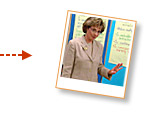Join us for conversations that inspire, recognize, and encourage innovation and best practices in the education profession.
Available on Apple Podcasts, Spotify, Google Podcasts, and more.
In this section, you will apply what you have learned to your own teaching. The three activities are designed to assist you in developing resources for assessing your students’ literacy development. Choose one or more from the list below to practice in your classroom.
Analyze a student’s performance records to plan appropriate instruction.
Plan a schedule for assessing your students’ reading and writing throughout the year.
Collect literacy resources for each workshop session in a Handbook for Effective Literacy Practices.
In this activity, you will assess the reading and writing performance of one of your students to guide your instruction.
To chart the student’s progress, repeat similar assessments throughout the year and adjust instruction accordingly. Compare Assessment Forms to consider how the student has progressed.
Assignment: Submit a completed Student Assessment Form.
Optional Viewing
 You may want to watch the workshop participants analyze samples from a first-grader’s literacy portfolio. Find this segment approximately 46 minutes and 30 seconds after the beginning of the video. Watch for about 5 minutes.
You may want to watch the workshop participants analyze samples from a first-grader’s literacy portfolio. Find this segment approximately 46 minutes and 30 seconds after the beginning of the video. Watch for about 5 minutes.
The Running Record (PDF) and letter to next year’s teacher (PDF) are also available for your reference.
In this activity, you will create a schedule of classroom assessments to use throughout the year.
The workshop participants raised several important questions about classroom assessment including how much to assess, when to assess, and what to assess.
Although assessment occurs daily, it is critical that specific assessments are in place and documented in a systematic way, to provide ongoing information about student performance and growth.
Consider the statement by Dr. Paratore:
You could learn about children’s literacy behaviors, performance, and interests in almost all areas of the day. What the effective teacher needs to do is develop some framework, some system for collecting and making sense of that data.
This activity will help you develop a framework for assessing and documenting student performance throughout the year — plan to ensure that you are collecting enough evidence for each student. The assessments should reflect your instruction and curriculum goals.
|
||||||||||||||||||||||||||||||||||||||||||||||||||||||||
Assignment: Submit your completed Assessment Schedule.
In this ongoing activity, you will collect literacy resources in a Handbook of Effective Literacy Practices to use in your classroom.
Idea
Do this activity with your colleagues to create a comprehensive collection of resources and instructional plans.
Today, you will create a section focused on using assessment in planning instruction. Include resources you already use, and plan to use in the future. Place these resources in the section for Using Assessment To Guide Instruction. You may want to include:
Assignment: Submit a copy of your completed Handbook at the end of the workshop series.
In this section, you will review and complete your notes on using assessment to guide instruction.
Review the notes you have taken during this session. Return to your Assessment Semantic Map you completed at the beginning of the session. Add any new ideas and practices for assessing children’s literacy development. Use your revised map and the following questions to reflect on the ideas presented in this session. In a paragraph, respond to the following questions:
Assignment: Submit your written reflection.